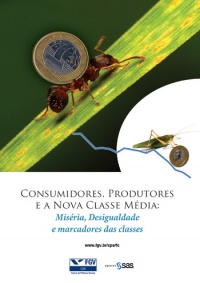
Consumers, Producers and the New Middle Class
About the research:
Click here to see the content of the research
The research explores through PNAD the evolution of the different assets stocks of the families, with a wide view of the nature of the living standards acquired. We have translated the wealth of data into terms of classification of economic classes, grouped into two perspectives: the consumers and the producers. The first one identifies the consumption potential of the families through access to consumption goods like TV, freezer, etc.; access to public services, such as waste collection and sewerage; housing conditions (financing, size) and type of families. The producer´s perspective we have identified the potential of household income generation through productive inclusion and the educational level of different members of the household, as well investments in physical capital (public and private pensions; use of information and communications technology); social capital (unions, family structure) human capital (how many children are attending public or private school), so as to capture the sustainability of the income. Comparing these two dimensions, consumers and producers, allows us to separate the Brazilians as grasshoppers and ants as in the la Fontaine fables. Besides, from the microdata of 132 countries, we contrasted the specificities of the Brazilian people in relation to the present and the future, theirs and the country´s.
Additionally, the research unveils the evolution of social indicators based on household per capita income traditionally generated by the CPS, as poverty, inequality including null incomes, economic classes (AB, C, D e E) synthesizing what happened to the wealth of Brazilian families of different economic classes. We analyzed the immediate impact of different income sources. For instance, what was the relative importance of income from work, social security benefits or the Family Grant to explain the reasons for alteration in the indicators based on income flows (poverty, inequality and classes) as well as its higher or lower prospective sustainability. Illustratively, among 2008 and 2007 PNADs there was a 12% reduction in poverty, or 3.8 million people out of poverty. This movement crowns a trend since the end of the 2003 recession, when poverty dropped 42,9%, that is, around 19,3 million people have crossed the poverty line. The result is that we have 29,3 million poor people (16,02% of the population) who would be 50 million people instead had poverty not fallen in the last years.




